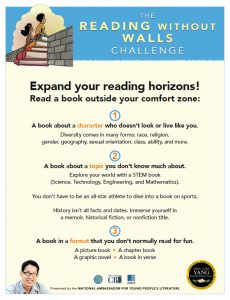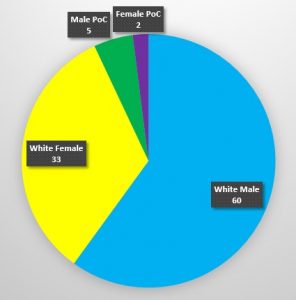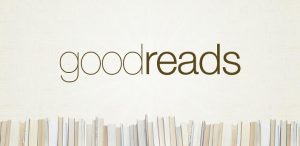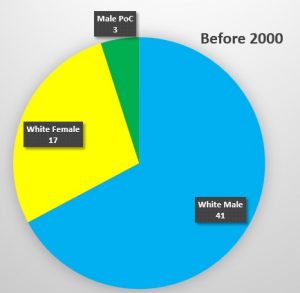Like many of you, dear readers, I read a lot of books. Moreover, I spend a lot of time reading things about books…indeed, some of the links on the left-hand side of this page will bring you to our favorite places on the internet for reading about books.
Some of these readings make me very happy, like the Children’s Book Council’s “Reading Without Walls” Initiative, which encourages younger readers to explore books of diverse voices, genres, and formats. Here is the poster that the CBC produced for the challenge:

How cool is this?! Helping readers to realize just how many options are available to them, how many voices, how many format, and how many genres, is a terrific way to foster a lifelong love of reading. Moreover, studies have shown that reading, particularly reading fiction, helps build up empathy. And Heavens knows that this world needs as many empathetic people as it can get.
I also really appreciate that this challenge also focuses on different formats of books. I’ve written about my own struggles reading graphic novels, which I attribute, in large part to the fact that I didn’t realize they even existed until I was a lot older. And as much as I hate to admit it, it is more difficult for an older brain to adapt to new stuff. So getting readers’ minds and eyes (and ears!) adapted to as many formats as possible as early as possible ensures that they can enjoy All The Books as they continue to grow.
But the real importance of this project wasn’t driven home for me until I saw this article on BookRiot, entitled “A deep dive into Goodreads Top 100 Mysteries and Thrillers“, and discussed the diversity of the authors listed. As you will see in the graph below, which we borrowed with respect from BookRiot, the Mysteries and Thrillers market is dominated by white men:

Now, I have a number of issues with Goodreads (much of which I blame on you, Amazon), which we can talk about in-depth later, but the gist of it is that their numbers, and especially their ratings, are seldom based on actual living-in-reality fact-based statistics. If anyone followed the vicious, misogynistic movement to make the new Ghostbuster’s movie the lowest-rated on IMBD, you’ll know to what I am alluding here. Indeed, Goodreads admitted this was a popularity contest, stating “every one of these books has at least a 4.0 rating from the Goodreads community.” In order for a book to make it onto Goodreads’ radar like that, it has to be read by a lot of people (admittedly, who had to then have enjoyed their reading experiences–which is terrific. Yay reading books you enjoy!)
 But what we are actually seeing here is a reflection, not of the best books, but of market trends. No one was asked “what is the best mystery book you ever read”. Instead, the aggregate ratings of a website that is A) Owned by Amazon* B) Reliant on user input. If you don’t have internet access or a Goodreads account, you can’t play this game. More than likely, you are only going to list books read in the last decade or so. I know that two of my favorite mysteries as a younger reader was The Westing Game and The Haunting of Cassie Palmer, but I never listed them on Goodreads because I didn’t get a Goodreads account until I was in my late 20’s, and if I tried to list all the books I had read to date at that time I’d have starved to death before I finished.
But what we are actually seeing here is a reflection, not of the best books, but of market trends. No one was asked “what is the best mystery book you ever read”. Instead, the aggregate ratings of a website that is A) Owned by Amazon* B) Reliant on user input. If you don’t have internet access or a Goodreads account, you can’t play this game. More than likely, you are only going to list books read in the last decade or so. I know that two of my favorite mysteries as a younger reader was The Westing Game and The Haunting of Cassie Palmer, but I never listed them on Goodreads because I didn’t get a Goodreads account until I was in my late 20’s, and if I tried to list all the books I had read to date at that time I’d have starved to death before I finished.
So what we have is a market that isn’t designed for people who are reading without walls. And that’s where you come in.
Because while this survey can show us very broad changes over time–for example, that there are more authors of color on the list now than there were in 2000 (see the graph below)–it can’t show us how individual reading trends have changed. If everyone and their mother and their father and their Aunt Rose are reading James Patterson, then the fact that Aunt Rose also went out and discovered Attica Locke’s The Cutting Season means nothing to Goodreads. But I can guarantee you that it will mean something to Aunt Rose. And I bet that being exposed to different cultures, different voices, different ways of telling stories, will mean something to you, too.

So come on into the Library and check out our “Reading Without Walls” Display for grown-up readers, and try something new. I’ll be giving it a whirl, too, beloved patrons, so we can compare notes as we explore all the stories this big world (and even bigger universe!) has to offer!
*For the Record: There are aspects of Amazon that I think are terrific–namely, that they have opened the book world to millions of readers who live in book deserts, and opened an e-book market that has made reading (and writing) easier for millions more. Amazon Smile also lets you donate to NOBLE, which is great. However, it has also, and continues to do a lot of harm to authors, to independent bookstores, and to readers. So while I respect the good the corporation has done, I’ll always be a wee bit skeptical of it.
